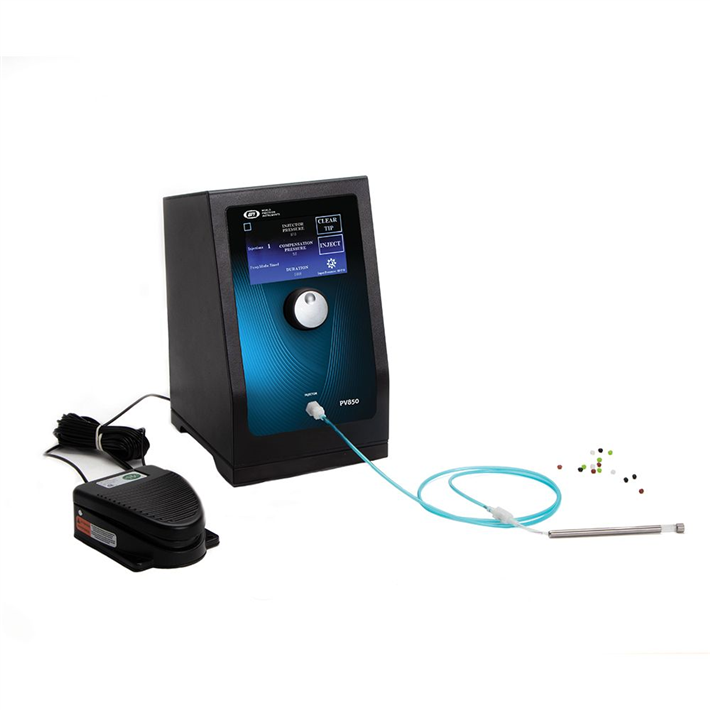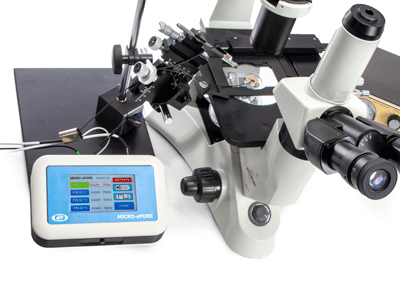
New Technology Makes Microinjection More Reliable, Repeatable and Affordable
Microinjection is the process of transferring genetic materials into a living cell using glass micropipettes or metal microinjection needles. Glass micropipettes can be of various sizes with tip diameters ranging from 0.1 to 10 µm. DNA or RNA is injected directly into the cell’s nucleus. Microinjection has been successfully used with large frog eggs, mammalian cells, mammalian embryos, plants and tissues. Microinjection has been expensive, can be a slow process and requires skilled personnel, but new technologies are making it even more reliable, repeatable and affordable.
Pronuclear injection, inserting DNA or RNA into the nucleus of a fertilized oocyte to create transgenic organisms, lets researchers study the role of particular genes. This horizontal gene transfer can insert genetic material from the same species or a different one. When using genetic material from different species, a chimera is created. If the genetic material is NOT integrated into the genome of the offspring, it is considered transient transformation and is not passed to subsequent generations. However, if the new genetic material is transferred to future generations, then we have a stable transformation. In this case, the gene inserted by microinjection is called as the transgene, and the organism that develops after a successful gene transfer is called as transgenic.
So, transgenic animals are the results of experimentation that integrates genetic material (DNA) into their germ line. These transgenic animals are invaluable in the quest to identify the functions of specific factors in homeostatic systems through the over-expression or under-expression of a modified gene. In many cases transgenic animals are dependent on the laboratory environment for survival.
Microinjection is a highly reproducible and repeatable method of introducing genetic material into a nucleus. (Qingsong Xu. Micromachines for Biological Micromanipulation. Springer Publication, 2018.) Compared with other methods of genetic manipulation, microinjection optimized the materials used and eliminates a lot of waste. (Chow YT, Chen S, Wang R, et al. Single Cell Transfection through Precise Microinjection with Quantitatively Controlled Injection Volumes. Sci Rep. 2016;6:24127. Published 2016 Apr 12. doi:10.1038/srep24127.) Because the materials used are minimized, there is also a reduction in the cost of the materials needed. With the tight control of the microinjection process, the researcher can obtain the precise integration of the recombinant gene in a limited number of copies.
Products for Efficient Microinjection
WPI offers a broad range of laboratory equipment used for microinjection applications. Our injection systems have been serving scientist for over 30 years. Additionally, WPI offers a variety of accessories for microinjection including pumps, pullers, pipetters, microscopes and more. One of the most popular pumps for zebrafish and adherent cell microinjection is the PV820 Pneumatic PicoPump.
Injection Pumps

Originally, the PV820 and PV830, Pneumatic PicoPumps and the MICRO-ePUMP, were designed to simplify intracellular injection. The microinjection offering was redesigned in 2020 from the ground up to offer ease of use, ensure repeatable operations and cover a broader range of applications. You get touch screen control, footswitch operation and a unit that takes up precious little bench space. Researchers get repeatable microinjections in volumes ranging from picoliters to nanoliters. Our microinjectors offer eject and hold pressure. To guard against injectant dilution, the hold pressure prevents backfilling of the pipette via capillary action, keeping the injectant meniscus at the pipette tip. WPI also has popular pumps for injecting in the picoliter and nanoliter ranges.
Pinpoint Cell Penetrator

The new WPI MICRO-ePORE™ pinpoint cell penetrator is a simple and versatile system that can be used for efficient microinjection of a diverse array of compounds and biomolecules into oocytes and pre-implantation stage mammalian embryos. Patent pending Flutter Electrode Technology assists in small, clean, precise membrane penetration without tearing or damaging the membrane when one is working on the microinjection of transgenic animals or cell manipulation. WPI's MICRO-ePORE™ Pinpoint Cell Penetrator offers several advantages over traditional electroporation for the purpose of microinjection.
- The pinpoint cell penetrator uses a much lower voltage to open a port into the cell membrane.
- Electroporation is a shotgun approach that opens many pores in the cell membrane. In contrast, the pinpoint cell penetrator targets a specific area of the cell membrane at the very point of microinjection.
- Survivability of embryos is significantly higher when using pinpoint cell penetration versus electroporation.
Microscope
WPI’s PZMIII-MI Microscope with Illuminated Base and Articulating Mirror is perfect for microinjection and transfection. It includes a standard stereo microscope head mounted on a research grade Brightfield/Darkfield pole type stand. It has a large stable work surface and a rotatable lens/mirror system which provides transmitted LED intensity illumination. The sliding mirror is gimbaled, allowing for a full range of movement front to back, as well as rotation. The mirror rotates 360º on one axis and can slide for further lighting effect directionally, front to back. A knob on the right of the base adjusts the mirror and a locking ring holds the desired mirror position. Vary the microscope illumination from Brightfield LED to Darkfield LED at an appropriate angle using the articulating mirror. It is an effective tool for viewing live bacteria. At low magnifications, view tissues, cells or embryo transfer where oblique, transmitted illumination is critical.
Get More Information
Microinjection is a revolutionary tool in the age of modern science. These methods allow any lab to incorporate the technique of microinjection into their experimental repertoire.
Whether DNA, RNA or protein is the molecule of interest, microinjection provides a means of studying function within the context of the living cell. The technology is remarkably accessible and relatively inexpensive, while the possibilities are virtually endless.

PZMIII-MI
Binocular Stereo Microscope with LED Illuminated Base and Articulating Mirror

PZMTIII-MI
Trinocular Stereo Microscope with LED Illuminated Base and Articulating Mirror







Request
Catalogue
Chat
Print